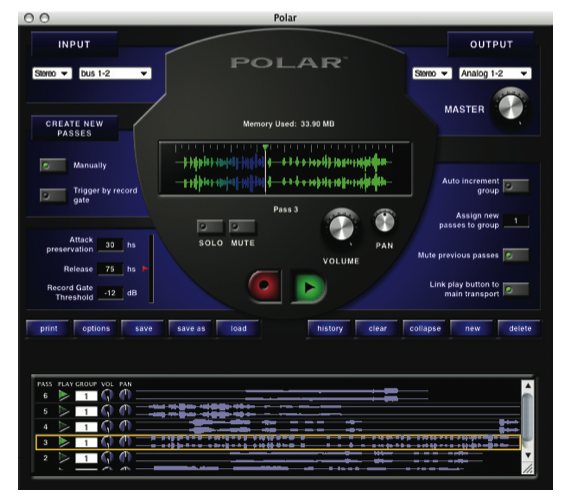POLAR
The POLAR window is a self-contained audio recording module within the general environment of Digital Performer. What makes POLAR different from Digital Performer's usual audio track-based recording is this: POLAR records your audio entirely into RAM, rather than writing it to a hard disk. Because RAM is so much faster, it allows Digital Performer to be much more interactive with you during recording, allowing you to immediately loop newly recorded material, overdub (merge) new audio data with existing audio, and otherwise respond instantaneously to your actions.

A typical POLAR session might go as follows: you import a 4-bar drum loop, place it in a regular audio track in the Tracks window and set up the memory cycle points around it so you can loop-record over it in the POLAR window.
You open POLAR and record a bass line over the drum loop. You like it, but you want to try again to see if you can lay down something a little better. You start playing another bass line and as soon as you start playing, POLAR automatically mutes the first pass for you (so it doesn't interfere with your new pass). You then record several more takes, automatically muting each previous pass as you begin recording a new one. Each take is stored as its own "pass" in the list at the bottom of the window.
After choosing the bass line you like the best (by muting all the other passes), you proceed to some layered percussion. This time, you use POLAR's overdub recording capabilities, recording each percussion instrument into the same pass. The result is one pass with all of the percussion parts in it.
Using these same techniques, you add rhythm guitar and a lead guitar solo on top, mixing as you go with the mute, volume and pan controls for each pass.
When you're done, you click the Print button in the POLAR window, which writes the session to disk as audio files and adds the session to the sequence as a single hard disk track right below the drum loop you started with. (Or, if you prefer, you can print each pass as its own separate track.) Finally, you click the Save button in the POLAR window to save the entire POLAR session as its own document. This allows you to go back to the POLAR session at any time —exactly as you saved it — for further tweaking, layering, or other modifications.
RAM-based loop recording
The scenario above is just an example. Generally speaking, POLAR is ideal for any recording situation that calls for recording multiple passes of material, and either layering the passes on top of one another or recording each pass individually, storing each pass as a "take" that gets muted as you begin a new take.
Recording in context
One of the best things about POLAR is that you can play the rest of your sequence — both MIDI and audio — while recording into it.
Saving your POLAR session
When you're done recording into POLAR, you can "print" your RAM-based audio as hard disk audio — and even automatically create tracks, right along side your current MIDI and audio tracks — to save them with the rest of your Digital Performer project. Or you can save your POLAR session as its own document. You can even do both, so that you can always go back to the original POLAR session for further modification.
Ideas for using POLAR
Here are a few ideas for how you can use POLAR:
- For years, Digital Performer has allowed you to build MIDI drum loops by overdub recording into a MIDI track. Now you can do this sort of thing with audio in the POLAR window!
- Remember the EchoPlex™? For those of you that don't, it was a device introduced in the 70's that let you record a short phrase and then build on top of it. POLAR is ideal for building this type of layered effect.
- POLAR is also ideal for recording multiple takes of the same material, such as multiple takes for solos, etc.
- How about writing entire sections of music? As long as you have enough RAM, you can build entire sections of music, interactively, in real time.